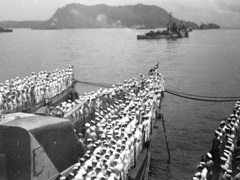
O’Bannon Presidential Unit Citation presentation, New Guinea, viewed from Nicholas with Radford at left.
The first two Fletchers launched and commissioned, they plus Fletcher were the only ships of the class to arrive in the Pacific in September–October 1942 during the Guadalcanal Campaign. On 12 November, these three ships were escorting a nearby convoy when Adm. Daniel Callaghan saw the need to add destroyers to his task force; while Nicholas stayed with the convoy, O’Bannon and Fletcher featured in the Friday-the-Thirteenth naval Battle of Guadalcanal.
As we all know, the O’Bannon, Chevalier and Selfridge did a bang up job the other night. On our arrival in port from our last mission, the following messages were sent and received:
FROM: COMDESRON 21
TO: O’BANNON
Congratulate you on your good work and your good fortune.
FROM: O’BANNON
TO: COMDESRON 21
Thank you for your message. We still seem to be lucky.
FROM: NICHOLAS
TO: O’BANNON
Heartiest congratulations from each and every one of us. We are proud to know you. Best of luck in all your future operations.
FROM: O’BANNON
TO: NICHOLAS
To the Nicholas gang from the O’Bannon gang. It was nuttin fellows really it was nuttin.
From Nicholas’s Press News, published aboard ship October 21, 1943, following the battle of Vella Lavella, during which O’Bannon lost part of her bow in a collision with the sinking Chevalier.
Nicholas and O’Bannon continued to serve together in the Solomon Islands, both participating in frequent actions up the “Slot” including the Battles of Kula Gulf and Kolombangara, 5–6 and 12–13 July 1943 and the action off Horaniu, Vella Lavella, 18 August. Nicholas was alongside De Haven when the latter was lost to air attack in February, and in line ahead of Strong when that ship was torpedoed in July. O’Bannon engaged shore batteries while Chevalier rescued Strong survivors in July, then rammed the torpedoed Chevalier and picked up her survivors during the Battle of Vella Lavella in October.
Nicholas was chosen as flagship of their squadron and, with Radford, earned a Presidential Unit Citation for her action following the Battle of Kula Gulf. O’Bannon earned a Presidential Unit Citation for her overall action in the Solomons, presented with Nicholas and Radford in attendance (see photo above). Both were lucky to dodge enemy bombs and gunfire and to be missed by torpedoes that could easily have hit. Both sank enemy submarines; both were awarded Philippines Presidential Unit Citations.
Both were selected by Adm. Halsey to escort his flagship Missouri into Japanese waters at the end of the war. O’Bannon ended the war with 17 battle stars earned (a number surpassed only by aircraft carrier Enterprise’s 20, 7 of which were earned before O’Bannon earned her first); Nicholas earned 16. O’Bannon lost no shipmates throughout the war; Nicholas only two.
Throughout, their crews enjoyed the respect and esteem of one another and of the entire Navy—O’Bannon received a particular tribute by Adm. Halsey and was understood by many to be his favorite destroyer; the Nicholas received similar tributes by DesPac and Adm. Nimitz.
Mothballed and then recommission ed together nine years to the day after Nicholas was launched, they continued to serve with distinction, even escorting nuclear carrier Enterprise together off Vietnam in the late sixties. Finally, on 30 January 1970, they were decommissioned in the same ceremony, and sold for scrap. Both their names were taken by ships in today’s navy, and even by starships in science fiction.